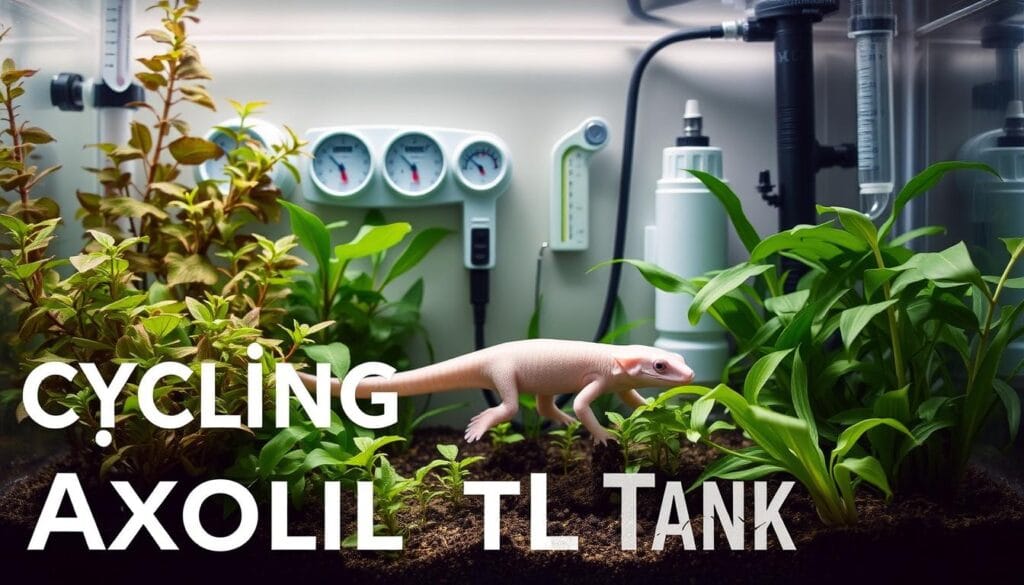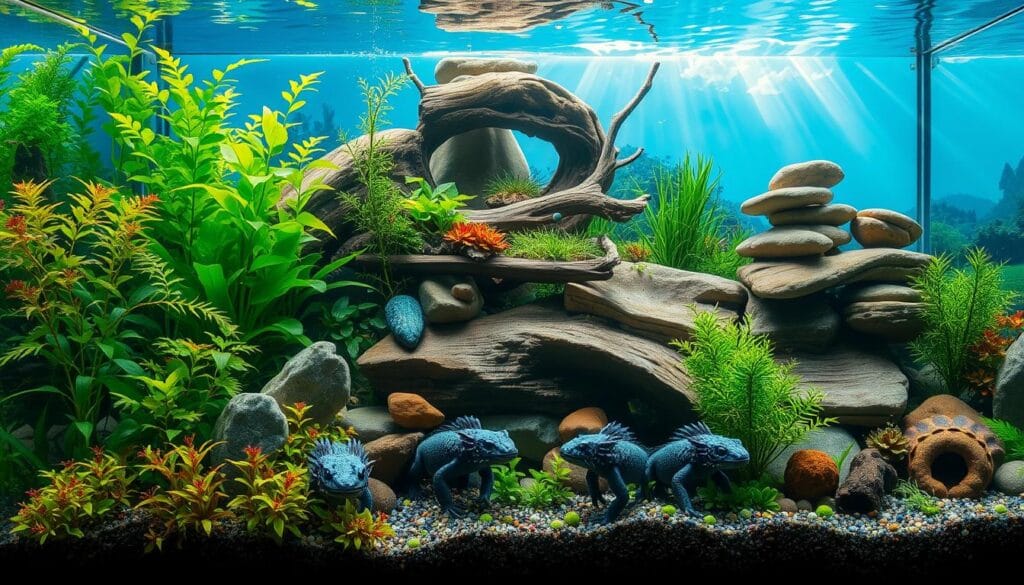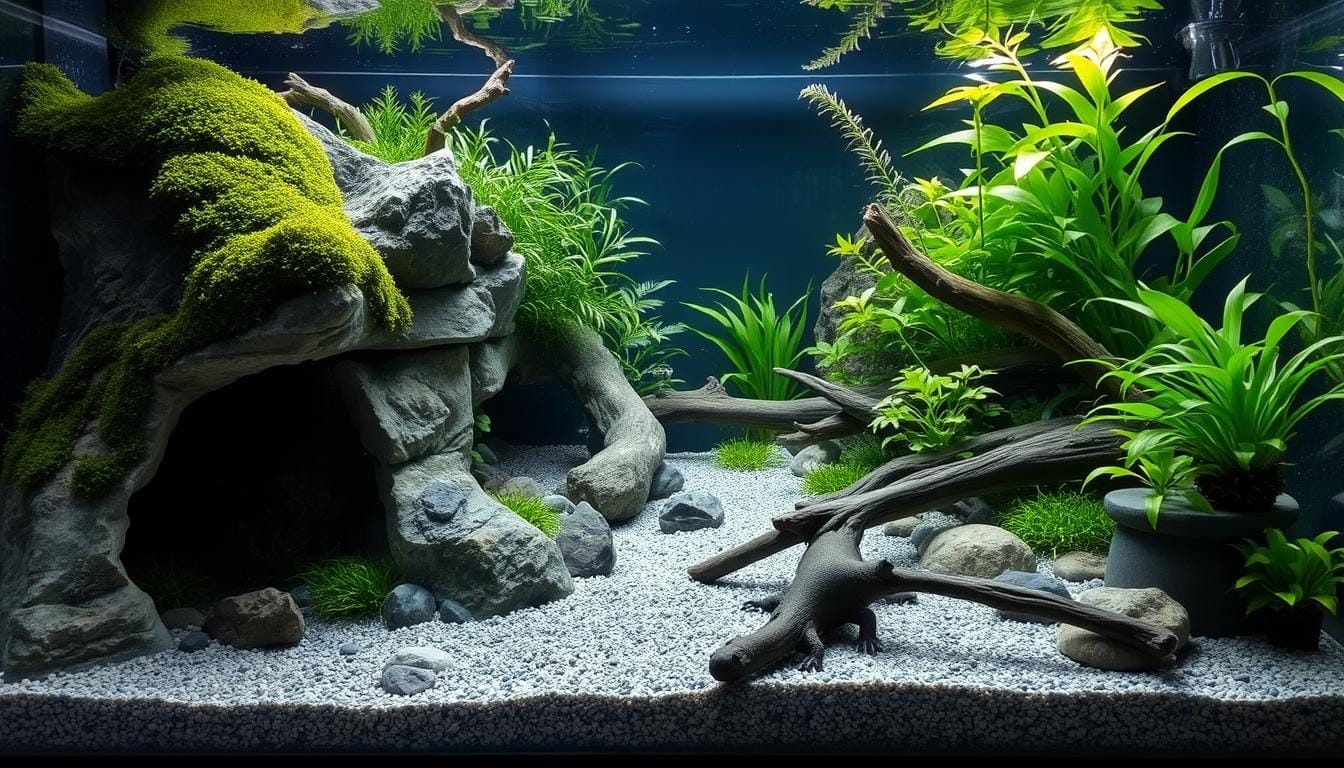Ever wondered how to make a magical underwater home for nature’s most fascinating creatures? Setting up an axolotl tank is more than just filling a glass box with water. It’s about creating a precise, loving space for these unique salamanders. They need special care that goes beyond regular aquarium upkeep.
When I first saw axolotls, I was amazed by their alien look and amazing healing powers. These incredible creatures need a habitat that closely matches their natural home. Your journey in caring for axolotls starts with knowing their specific needs and setting up a tank that lets them flourish.
Setting up a successful axolotl tank requires careful attention to detail. From choosing the right tank size to keeping the water just right, it’s crucial. Whether you’re new to axolotl care or want to enhance your current setup, this guide will help you create the perfect aquatic home.
Table of Contents
Understanding Axolotls
Axolotl care starts with knowing these amazing creatures. They are amphibians from Mexico’s lakes. They have traits that make them stand out from other water animals.
What is an Axolotl?
An axolotl is a special water salamander called Ambystoma mexicanum. They stay young forever, unlike other salamanders. This means they always have their gills and live in water.
Habitat and Natural Environment
Axolotls once lived in Mexico’s Lake Xochimilco and Lake Chalco. Now, they are very rare in the wild. They need:
- Cool, freshwater places
- Plenty of underwater plants
- Water that stays between 60-64°F
Behavior and Characteristics
To care for axolotls, you must know about their behavior. They are:
- Great at healing themselves
- Very calm and peaceful
- Can grow up to 9 inches long
They can even grow back lost body parts. This is why scientists and fans love them so much.
Choosing the Right Tank Size
Finding the perfect home for your axolotl begins with picking the right tank size. These special aquatic creatures need specific tank sizes to thrive. Knowing the ideal tank size is key for your pet’s health.
Minimum Tank Size Recommendations
Experts suggest these tank size guidelines for axolotls:
- Minimum tank size for a single axolotl: 20 gallons
- Recommended tank size per additional axolotl: 10-15 extra gallons
- Maximum recommended number of axolotls per tank: 2-3 individuals
Ideal Tank Dimensions
The tank’s shape is as important as its size. Axolotls like wider tanks for better horizontal movement. The best tank shapes include:
| Tank Type | Dimensions | Recommended For |
|---|---|---|
| 20-gallon Long | 30″ x 12″ x 12″ | Single axolotl |
| 40-gallon Breeder | 36″ x 18″ x 16″ | 2 axolotls |
Factors Influencing Tank Size
Several important factors affect your axolotl tank needs:
- Number of axolotls
- Expected adult size (up to 10 inches)
- Available space in your home
- Future growth potential
“A spacious tank is the foundation of a healthy axolotl habitat.” – Aquatic Pet Experts
Remember, a big tank helps prevent stress and keeps your pet healthy. Always choose width over height for your axolotl tank.
Essential Equipment for an Axolotl Tank
Setting up the perfect home for your axolotl is key. You need to pick the right tank accessories and filtration systems. It’s important to know what these special creatures need to stay healthy and happy.
Filtration Systems for Optimal Water Quality
Axolotl tank filters are vital for a clean, healthy space. These salamanders make a lot of waste. So, a strong filter that doesn’t move the water too much is needed.
- Recommended filter flow rate: 100-150 GPH for 20-gallon tanks
- Ideal brands for axolotl tank accessories include:
- Penn-Plax Cascade Canister Filter
- Aqueon Quietflow Canister Filter
- Zoo Med Nano External Canister Filter
| Filter Brand | Flow Rate | Tank Size | Dimensions |
|---|---|---|---|
| Penn-Plax Cascade | 115 GPM | Up to 30 gallons | 11.5 x 9 x 13.5 inches |
| Aqueon Quietflow | 200 GPM | 40-150 gallons | 16.25 x 14.34 x 14 inches |
| Zoo Med Nano | 160 GPM | Up to 30 gallons | 7.5 x 7.5 x 12.4 inches |
Heating and Lighting Considerations
Axolotls are cold-water animals. They don’t need a heater. Keep the water between 16-20°C (60-68°F). Soft, dim light is best to avoid stress and match their natural home.
Substrate Selection
Picking the right substrate is important. Large, smooth stones or bare-bottom tanks are best. Avoid small gravel to prevent blockages.
By choosing the right accessories and filtration, you’ll make a great home for your axolotl. This will keep them happy and healthy.
Setting Up the Tank
Creating the perfect home for your axolotl requires careful planning and attention to detail. An ideal axolotl tank setup involves more than just filling a tank with water. You’ll need to consider multiple factors to ensure your aquatic friend thrives in their new environment.
Preparing the Tank
Before adding your axolotl, thorough cleaning is crucial. Start by washing the tank with a mild, aquarium-safe cleaner. Rinse completely to remove any chemical residues that could harm your salamander. The goal is to create a pristine environment for your new pet.
Choosing the Right Axolotl Tank Substrate
Substrate selection is critical for axolotl tank setup. These delicate creatures prefer specific bottom conditions:
- Fine sand is the best axolotl tank substrate
- Bare tank bottom is also acceptable
- Avoid gravel or large rocks that could cause injury
Arranging Decorations and Hiding Spots
Axolotls need a comfortable environment with plenty of places to hide. Consider these tips:
- Use smooth, rounded decorations
- Create multiple hiding spots
- Ensure decorations have no sharp edges
- Use live or silk plants for natural coverage
Plant Selection and Positioning
When selecting plants for your axolotl tank, choose species that thrive in cooler water temperatures. Avoid plants with rough textures that might damage your axolotl’s delicate skin. Java moss and anubias are excellent choices that provide both aesthetic appeal and safe hiding spots.
Water Conditions for Axolotls
Creating the perfect aquatic environment is crucial for your axolotl’s health and happiness. Understanding the precise water conditions can make a significant difference in your pet’s quality of life. Axolotl tank requirements go beyond simply filling a tank with water.
Optimal Temperature Range
Axolotl tank temperature is a critical factor in maintaining their well-being. These unique amphibians thrive in cool water environments. The ideal temperature range is between 60-65° Fahrenheit (15-18° Celsius). Staying within these parameters helps prevent stress and potential health issues.
- Maximum safe temperature: 70° Fahrenheit (21° Celsius)
- Ideal temperature range: 60-65° Fahrenheit
- Use a reliable aquarium thermometer to monitor water temperature
pH Levels and Water Hardness
Maintaining the right water chemistry is essential for your axolotl’s survival. The recommended pH range is 7.2-7.6, which provides a stable and comfortable environment.
| Water Parameter | Ideal Range |
|---|---|
| General Hardness (GH) | 7-14 dGH (125-250 ppm) |
| Carbonate Hardness (KH) | At least 3 dKH (50+ ppm) |
Nitrogen Cycle Management
Keeping your axolotl’s water clean involves careful management of nitrogen compounds. Regular monitoring prevents toxic buildup that can harm your aquatic friend.
- Ammonia: 0 ppm
- Nitrite: 0 ppm
- Nitrate: Keep below 20 ppm
Perform weekly water changes of 20-30% to maintain optimal water quality. Consistent care is key to a healthy axolotl environment.
Cycling Your Axolotl Tank

Creating the perfect axolotl tank is more than just filling a container with water. Tank cycling is a key step to ensure a healthy home for your pet. It helps establish beneficial bacteria that break down harmful toxins.
Understanding the Cycling Process
Cycling your tank means setting up a balanced ecosystem that can handle waste. This process takes 1 to 3 months. It’s vital for your axolotl’s health.
Key Methods for Tank Cycling
- Fishless cycling using Ammonium Chloride
- Adding API QUICK START™ nitrifying bacteria
- Using bottled bacterial starters
Monitoring Water Parameters
While cycling, you must track important water parameters:
- Ammonia levels: Keep between 3-4 ppm
- pH levels: Keep between 7.6 and 8.0
- Nitrite levels: Must reach 0 ppm
- Nitrate levels: Ideally between 5-20 ppm
Testing for Tank Readiness
A cycled tank can handle 4 ppm of ammonia in 24 hours for three days. Test your water often during this time.
Pro tip: Avoid water changes during cycling unless ammonia exceeds 4 ppm or nitrates reach 160 ppm.
Creating the perfect axolotl tank takes patience. By cycling your tank carefully, you’ll give your pet a safe and healthy home.
Maintaining Water Quality
To keep your axolotl tank clean, you need to maintain the water quality. This is key for your pet’s health and long life.
Regular Water Changes
Changing the water regularly is vital for a healthy axolotl tank. Here are some important tips:
- Change 20-30% of the tank water each week
- Use a water testing kit to check the water
- Take out any debris or leftover food
- Keep the water temperature between 60-64°F
Monitoring Water Parameters
It’s important to watch your axolotl’s water conditions. This helps avoid health problems. Here’s a guide to water parameters:
| Parameter | Ideal Range | Frequency of Check |
|---|---|---|
| pH Level | 7.0-8.0 | Weekly |
| Ammonia | 0 ppm | Twice weekly |
| Nitrite | 0 ppm | Twice weekly |
| Nitrate | Below 20 ppm | Weekly |
Water Conditioners and Treatment
It’s crucial to protect your axolotl from harmful chemicals. Always treat tap water with a conditioner like API Tap Water Conditioner to remove chlorine and chloramines.
- Use water conditioners before adding new water to the tank
- Follow the manufacturer’s instructions carefully
- Choose safe water treatment products for axolotls
By following these water quality tips, you’ll make a safe and healthy home for your axolotl.
Feeding Your Axolotl
Axolotl care means giving them a diet that fits their needs. These unique aquatic salamanders need certain foods as they grow. Their diet changes from young to adult.
Best Food Options
Your axolotl needs a diet full of protein. Choose foods that are good for their health. Here are some great options:
- Live earthworms
- Adult brine shrimp
- Bloodworms
- Frozen freshwater shrimp
- Specialized sinking pellets
Feeding Frequency and Portions
How often and how much to feed your axolotl depends on its size and age. Here’s a guide:
| Axolotl Size | Feeding Frequency | Portion Size |
|---|---|---|
| Juvenile (up to 3 inches) | Daily, up to 3 times | 2-3 small worms |
| Growing (3-7 inches) | Twice daily | 3-4 medium worms |
| Adult (over 7 inches) | Every 2-3 days | 4-5 large worms |
Treats and Supplements
Remember, treats should be rare. Soft salmon pellets with 45% protein are great as a supplement. But, avoid foods with hard shells to prevent digestive problems.
Pro tip: Feed your axolotl food that’s smaller than its head. This helps prevent choking and ensures they digest it well.
Creating the Right Environment

Creating the perfect home for your axolotl is important. You need to think about tank accessories and the environment. These special creatures need a space that feels like home, with comfort and safety.
Plant Choices for Axolotl Tanks
Choose plants that do well in cool water and low light. Some great options include:
- Java Fern – tolerates low light and provides excellent hiding spots
- Anubias – slow-growing plant with sturdy leaves
- Marimo moss balls – decorative and help maintain water quality
“Creating a natural environment is key to keeping your axolotl healthy and stress-free.” – Aquatic Habitat Experts
Hiding Spots and Shelters
Axolotls need places to hide to feel safe. Your tank should have different shelters like:
- Ceramic cave structures
- Driftwood
- PVC tubes with smooth edges
- Large smooth rocks
Avoiding Harmful Decor
When picking tank accessories, safety first. Stay away from decorations with:
- Sharp edges that could damage delicate skin
- Small openings where axolotls might get stuck
- Rough surfaces that can harm their sensitive gills
Remember, a well-designed tank environment can significantly improve your axolotl’s quality of life and overall health.
Understanding Axolotl Behavior
Diving into the fascinating world of axolotl behavior reveals unique characteristics. Axolotl care requires a deep understanding of their natural instincts and communication signals.
Common Behaviors and Signs
Axolotls communicate through subtle body language and movement patterns. Here are key behavioral indicators to watch for:
- Gill movement indicates overall health and oxygen levels
- Floating near tank bottom suggests relaxation
- Rapid gill movement might signal stress or excitement
Social Needs and Interaction
Axolotls are mostly solitary creatures. They do not require social interaction and actually prefer minimal contact. Careful observation is crucial in axolotl care to understand their individual temperaments.
| Behavior | Meaning |
|---|---|
| Gill Curling | Potential stress response |
| Tail Curling | Defensive posture |
| Frequent Hiding | Desire for privacy or feeling threatened |
Recognizing Stress Signals
Axolotl care involves understanding potential stress indicators. Watch for these warning signs:
- Unusual color changes
- Decreased appetite
- Reduced movement
- Excessive gill movement
By paying close attention to these behavioral nuances, you can ensure a comfortable and healthy environment for your unique aquatic companion.
Common Health Issues in Axolotls
Axolotl care is all about watching out for health problems. Knowing the signs of illness and taking steps to prevent it can keep your axolotl healthy. This way, it can thrive in its home.
Recognizing Signs of Illness
Many things can harm your axolotl’s health. Look out for these important warning signs:
- Unusual skin discoloration or lesions
- Loss of appetite lasting over 48 hours
- Lethargy or reduced movement
- Gill deterioration or inflammation
- Abnormal swimming patterns
Preventative Health Measures
Keeping the water right is key for axolotl care. Here are some important steps to take:
- Maintaining water temperature between 16-20°C
- Keeping pH levels between 6.5-7.5
- Performing regular 20-30% weekly water changes
- Monitoring water parameters consistently
- Providing a stress-free environment
When to Seek Veterinary Help
It’s time to see a vet if your axolotl’s health doesn’t get better. Look for these signs:
- Significant behavioral changes
- Visible infections
- Unexplained weight loss
- Respiratory difficulties
Take your axolotl to an exotic pet vet who knows about aquatic animals. They can give the best care and treatment.
Conclusion: Your Axolotl’s Perfect Home
Creating the perfect axolotl tank setup needs dedication and attention to detail. Your care can make these fascinating creatures long-term companions. They can live over 10 years with the right care.
Keeping axolotls involves knowing their environmental needs. This includes water temperature and what they eat. It’s all about creating a stable home for them.
Your success with axolotls comes from regular checks and upkeep. Changing the water, controlling the temperature, and feeding them right are key. They thrive in a stable environment with clean water and a habitat that feels like home.
Key Takeaways
Axolotl lovers should focus on the tank’s quality and the environment. A 20-gallon tank is perfect for one axolotl, giving them space to grow and explore. Keeping the water right, feeding them well, and creating a calm space helps them stay healthy.
Final Encouragement
Take on the challenge of axolotl care with patience and passion. These amazing creatures open a window to an underwater world. They reward their owners with their resilience and interesting behaviors.
Your dedication can also help protect these endangered animals. Enjoying a unique pet-keeping experience is a bonus.

